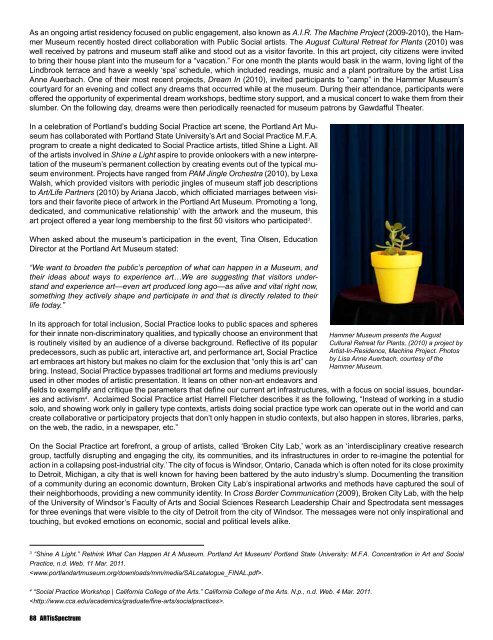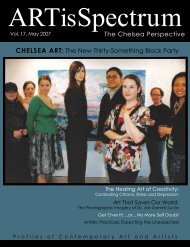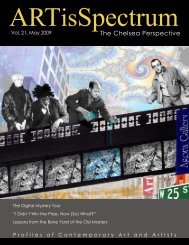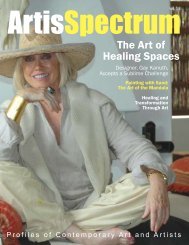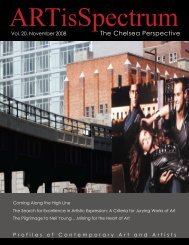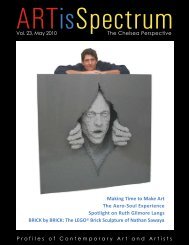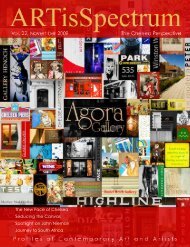Profiles of Contemporary Art and - ARTisSpectrum
Profiles of Contemporary Art and - ARTisSpectrum
Profiles of Contemporary Art and - ARTisSpectrum
You also want an ePaper? Increase the reach of your titles
YUMPU automatically turns print PDFs into web optimized ePapers that Google loves.
As an ongoing artist residency focused on public engagement, also known as A.I.R. The Machine Project (2009-2010), the Hammer<br />
Museum recently hosted direct collaboration with Public Social artists. The August Cultural Retreat for Plants (2010) was<br />
well received by patrons <strong>and</strong> museum staff alike <strong>and</strong> stood out as a visitor favorite. In this art project, city citizens were invited<br />
to bring their house plant into the museum for a “vacation.” For one month the plants would bask in the warm, loving light <strong>of</strong> the<br />
Lindbrook terrace <strong>and</strong> have a weekly ‘spa’ schedule, which included readings, music <strong>and</strong> a plant portraiture by the artist Lisa<br />
Anne Auerbach. One <strong>of</strong> their most recent projects, Dream In (2010), invited participants to “camp” in the Hammer Museum’s<br />
courtyard for an evening <strong>and</strong> collect any dreams that occurred while at the museum. During their attendance, participants were<br />
<strong>of</strong>fered the opportunity <strong>of</strong> experimental dream workshops, bedtime story support, <strong>and</strong> a musical concert to wake them from their<br />
slumber. On the following day, dreams were then periodically reenacted for museum patrons by Gawdafful Theater.<br />
In a celebration <strong>of</strong> Portl<strong>and</strong>’s budding Social Practice art scene, the Portl<strong>and</strong> <strong>Art</strong> Museum<br />
has collaborated with Portl<strong>and</strong> State University’s <strong>Art</strong> <strong>and</strong> Social Practice M.F.A.<br />
program to create a night dedicated to Social Practice artists, titled Shine a Light. All<br />
<strong>of</strong> the artists involved in Shine a Light aspire to provide onlookers with a new interpretation<br />
<strong>of</strong> the museum’s permanent collection by creating events out <strong>of</strong> the typical museum<br />
environment. Projects have ranged from PAM Jingle Orchestra (2010), by Lexa<br />
Walsh, which provided visitors with periodic jingles <strong>of</strong> museum staff job descriptions<br />
to <strong>Art</strong>/Life Partners (2010) by Ariana Jacob, which <strong>of</strong>ficiated marriages between visitors<br />
<strong>and</strong> their favorite piece <strong>of</strong> artwork in the Portl<strong>and</strong> <strong>Art</strong> Museum. Promoting a ‘long,<br />
dedicated, <strong>and</strong> communicative relationship’ with the artwork <strong>and</strong> the museum, this<br />
art project <strong>of</strong>fered a year long membership to the first 50 visitors who participated 3 .<br />
When asked about the museum’s participation in the event, Tina Olsen, Education<br />
Director at the Portl<strong>and</strong> <strong>Art</strong> Museum stated:<br />
“We want to broaden the public’s perception <strong>of</strong> what can happen in a Museum, <strong>and</strong><br />
their ideas about ways to experience art…We are suggesting that visitors underst<strong>and</strong><br />
<strong>and</strong> experience art—even art produced long ago—as alive <strong>and</strong> vital right now,<br />
something they actively shape <strong>and</strong> participate in <strong>and</strong> that is directly related to their<br />
life today.”<br />
In its approach for total inclusion, Social Practice looks to public spaces <strong>and</strong> spheres<br />
for their innate non-discriminatory qualities, <strong>and</strong> typically choose an environment that<br />
is routinely visited by an audience <strong>of</strong> a diverse background. Reflective <strong>of</strong> its popular<br />
predecessors, such as public art, interactive art, <strong>and</strong> performance art, Social Practice<br />
art embraces art history but makes no claim for the exclusion that “only this is art” can<br />
bring. Instead, Social Practice bypasses traditional art forms <strong>and</strong> mediums previously<br />
used in other modes <strong>of</strong> artistic presentation. It leans on other non-art endeavors <strong>and</strong><br />
Hammer Museum presents the August<br />
Cultural Retreat for Plants, (2010) a project by<br />
<strong>Art</strong>ist-In-Residence, Machine Project. Photos<br />
by Lisa Anne Auerbach, courtesy <strong>of</strong> the<br />
Hammer Museum.<br />
fields to exemplify <strong>and</strong> critique the parameters that define our current art infrastructures, with a focus on social issues, boundaries<br />
<strong>and</strong> activism 4 . Acclaimed Social Practice artist Harrell Fletcher describes it as the following, “Instead <strong>of</strong> working in a studio<br />
solo, <strong>and</strong> showing work only in gallery type contexts, artists doing social practice type work can operate out in the world <strong>and</strong> can<br />
create collaborative or participatory projects that don’t only happen in studio contexts, but also happen in stores, libraries, parks,<br />
on the web, the radio, in a newspaper, etc.”<br />
On the Social Practice art forefront, a group <strong>of</strong> artists, called ‘Broken City Lab,’ work as an ‘interdisciplinary creative research<br />
group, tactfully disrupting <strong>and</strong> engaging the city, its communities, <strong>and</strong> its infrastructures in order to re-imagine the potential for<br />
action in a collapsing post-industrial city.’ The city <strong>of</strong> focus is Windsor, Ontario, Canada which is <strong>of</strong>ten noted for its close proximity<br />
to Detroit, Michigan, a city that is well known for having been battered by the auto industry’s slump. Documenting the transition<br />
<strong>of</strong> a community during an economic downturn, Broken City Lab’s inspirational artworks <strong>and</strong> methods have captured the soul <strong>of</strong><br />
their neighborhoods, providing a new community identity. In Cross Border Communication (2009), Broken City Lab, with the help<br />
<strong>of</strong> the University <strong>of</strong> Windsor’s Faculty <strong>of</strong> <strong>Art</strong>s <strong>and</strong> Social Sciences Research Leadership Chair <strong>and</strong> Spectrodata sent messages<br />
for three evenings that were visible to the city <strong>of</strong> Detroit from the city <strong>of</strong> Windsor. The messages were not only inspirational <strong>and</strong><br />
touching, but evoked emotions on economic, social <strong>and</strong> political levels alike.<br />
3<br />
“Shine A Light.” Rethink What Can Happen At A Museum. Portl<strong>and</strong> <strong>Art</strong> Museum/ Portl<strong>and</strong> State University: M.F.A. Concentration in <strong>Art</strong> <strong>and</strong> Social<br />
Practice, n.d. Web. 11 Mar. 2011.<br />
.<br />
4<br />
“Social Practice Workshop | California College <strong>of</strong> the <strong>Art</strong>s.” California College <strong>of</strong> the <strong>Art</strong>s. N.p., n.d. Web. 4 Mar. 2011.<br />
.<br />
88 <strong>ARTisSpectrum</strong>


